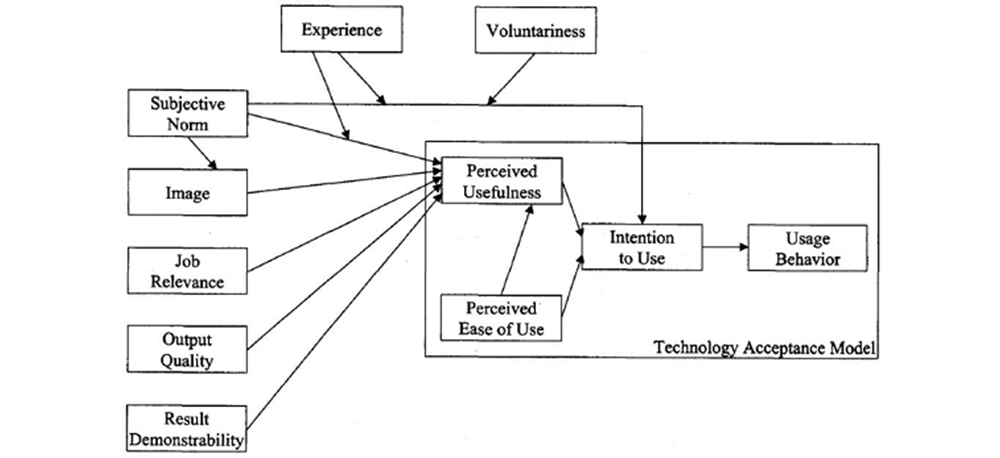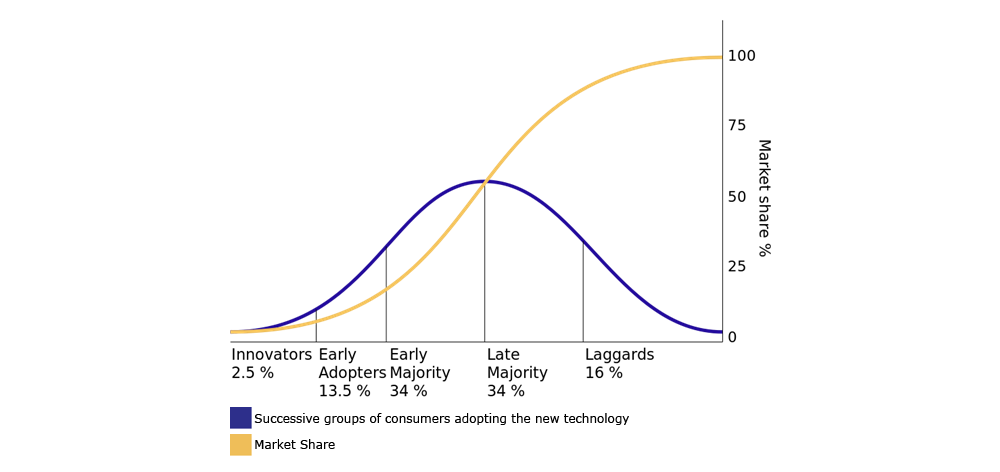Mini Challenge One
Q1. How should we take into account the impacts of technology on people who aren’t users of it at the time? That might mean users at times when they’re not using what we build, or other people who’re never users of the technology. Should other ways of relating to technology be part of design thinking?
When designing for people who are not users of that time then one of the important considerations to be taken into account is the Technology Acceptance Model. The Technology Acceptance Model (TAM) is an information systems theory that models how users come to accept and use a technology. The model suggests that when users are presented with a new technology, a number of factors influence their decision about how and when they will use it, notably:
Perceived usefulness (PU) - This was defined by Fred Davis as "the degree to which a person believes that using a particular system would enhance his or her job performance".
Perceived ease-of-use (PEOU) - Davis defined this as "the degree to which a person believes that using a particular system would be free from effort" (Davis 1989).
Thus to maximise the impact of technology when designing for people who are not using it at the present, we must correlate it to the technology acceptance model. More it satisfies the condition of the model, the better the impact.

Venkatesh, V. and Davis, F.D. "A Theoretical Extension of the Technology Acceptance Model: Four Longitudinal Field Studies," Management Science, 46, 2000, 186-204. [Abstract]

Davis, F. D., Bagozzi, R. P., and Warshaw, P. R. "User Acceptance of Computer Technology: A Comparison of Two Theoretical Models," Management Science, 35, 1989, 982-1003. [Abstract]
Q2. Does technology change quickly or slowly in relation to the experiences or people that you’re designing for? And what might the consequences be of those differences?
Yes. A lot of changes happen in technology over the time at a steady rate. A major factor for the transformation in technology apart from innovation happening over time is the time is user needs that are ever changing. Technology evolves in a manner to accommodate different and new user groups.
A great example would be the PC which started with a command line editor and eventually transformed in a UI.
Another example could be the conventional TV, which got a remote and eventually evolved to SmartTVs which can identify gestures. In both the examples, the hardware has also seen a significant change. The ball mouse, CRT screen got replaced over the time.

The diffusion of innovations according to Rogers (1962). With successive groups of consumers adopting the new technology (shown in blue), its market share (yellow) will eventually reach the saturation level.
Q3. If the vision of the Internet of Things become a lived reality, then things, people, environment, infrastructure and a whole lot of stuff can potentially communicate, collaborate, and actuate (do things). How might such a reality affect our understanding of food?
By using IoT-connected, data-driven devices to sense and control the physical world, you can unlock massive, previously unseen opportunities to optimize the supply chain—from production to distribution and consumption—boost margins and delight customers. When you integrate previously hidden bits of information with key business systems, such as fleet and warehousing management, you can gain surprising new insights that actually transform your business.
The IoT makes possible a new cooperative between food producers, transportation and hospitality/retail companies who can work together as never before to ensure efficient delivery and food safety. With IoT-based business solutions, companies across the supply chain gain the real-time visibility and enable the automated, intelligent actions needed to ensure food is of the highest quality, delivered on time and prepared in optimal settings.
For Consumers: We can assume a situation where the kitchens and referigerator become smart enough that they are able to suggest recipes based on the available resources, moods, geography, culture, and time of the day. This is one of the application that might help to reconstruct the current way how food is seen.
For Manufacturers: For instance, food companies that use IoT-connected testing equipment can confirm food quality as it leaves the factory or warehouse. Fleet managers can then leverage the IoT to make sure temperature-sensitive, perishable goods don’t go bad in transit through sensor-enabled refrigeration systems. Any temperature fluctuations can trigger alerts that automatically adjust the truck’s refrigeration. If the system is not able to auto-correct, an alert can be sent to the food supplier, who can replace bad goods before they arrive at the customer’s dock. And by using an IoT-based fleet management solution to enable continual visibility into connected trucks, trucking managers can optimize routing and ensure on-time delivery of the new goods via an alternate vehicle. In the end, the customer receives quality goods on time and is never aware there was an issue. Plus, the sensor-enabled refrigeration system can send alerts to the manufacturer, pinpointing the exact part that broke down and facilitating faster replacement and fixes.
Not only can food suppliers and trucking companies identify ways to improve efficiencies and drive down costs, customers can track their supplies to see if shipments will arrive when expected. And then, once arrived, use connected devices to ensure food safety on site.
OzCHI24 Design Challenge